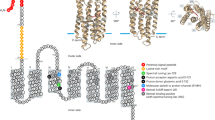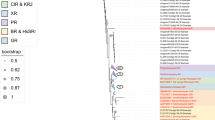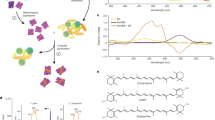Abstract
Proteorhodopsins (PR) are retinal-binding membrane proteins that function as light-driven proton pumps to generate energy for metabolism and growth. Recently PR-like genes have been identified in some marine eukaryotic protists, including diatoms, dinoflagellates, haptophytes and cryptophytes. These rhodopsins are homologous to green-light-absorbing, ATP-generating PRs present within bacteria. Here we show that in the oceanic diatom Pseudo-nitzschia granii, PR-like gene and protein expressions increase appreciably under iron limitation. In a survey of available transcriptomes, PR-like genes in diatoms are generally found in isolates from marine habitats where seasonal to chronic growth limitation by the micronutrient iron is prevalent, yet similar biogeographical patterns are not apparent in other phytoplankton taxa. We propose that rhodopsin-based phototrophy could account for a proportion of energy synthesis in marine eukaryotic photoautotrophs, especially when photosynthesis is compromised by low iron availability. This alternative ATP-generating pathway could have significant effects on plankton community structure and global ocean carbon cycling.
Similar content being viewed by others
Log in or create a free account to read this content
Gain free access to this article, as well as selected content from this journal and more on nature.com
or
References
Beja O, Aravind L, Koonin EV, Suzuki MT, Hadd A, Nguyen LP et al. (2000). Bacterial rhodopsin: evidence for a new type of phototrophy in the sea. Science 289: 1902–1906.
de Baar HJW, Boyd PW, Coale KH, Landry MR, Tsuda A, Assmy P et al. (2005). Synthesis of iron fertilization experiments: from the iron age in the age of enlightenment. J Geophys Res-Oceans 110: C09S16.
Fuhrman JA, Schwalbach MS, Stingl U . (2008). Proteorhodopsins: an array of physiological roles? Nat Rev Microbiol 6: 488–494.
Garcia HE, Locarmini RA, Boyer TP, Antonov JI, Zweng MM, Baranova OK et al. (2009). World Ocean Atlas, Volume 4: nutrients (phosphate, nitrate, silicate). In: Levitus S (ed.), NOAA Atlas NESDIS 71. USA Government Printing Office: Washington, DC, USA, p 398.
Keeling PJ, Burki F, Wilcox HM, Allam B, Allen EE, Amaral-Zettler LA et al. (2014). The Marine Microbial Eukaryote Transcriptome Sequencing Project (MMETSP): illuminating the functional diversity of eukaryotic ife in the oceans through transcriptome sequencing. PLoS Biol 12: e1001889.
Lin S, Zhang H, Zhuang Y, Tran B, Gill J . (2010). Spliced leader-based metatranscriptomic analyses lead to recognition of hidden genomic features in dinoflagellates. Proc Natl Acad Sci USA 107: 20033–20038.
Marchetti A, Schruth DM, Durkin CA, Parker MS, Kodner RB, Berthiaume CT et al. (2012). Comparative metatranscriptomics identifies molecular bases for the physiological responses of phytoplankton to varying iron availability. Proc Natl Acad Sci USA 109: E317–E325.
Oesterhelt D, Stoeckenius W . (1971). Rhodopsin-like protein from the purple membrane of Halobacterium halobium. Nat New Biol 233: 149–152.
Raven JA . (2009). Functional evolution of photochemical energy transformations in oxygen-producing organisms. Funct Plant Biol 36: 505–515.
Raven JA, Evans MCW, Korb RE . (1999). The role of trace metals in photosynthetic electron transport in O2-evolving organisms. Photosynth Res 60: 111–149.
Slamovits CH, Okamoto N, Burri L, James ER, Keeling PJ . (2011). A bacterial proteorhodopsin proton pump in marine eukaryotes. Nat Commun 2: 183.
Spudich JL, Yang CS, Jung KH, Spudich EN . (2000). Retinylidene proteins: Structures and functions from archaea to humans. Annu Rev Cell Dev Biol 16: 365–392.
Strzepek R, Harrison P . (2004). Photosynthetic architecture differs in coastal and oceanic diatoms. Nature 431: 689–692.
Acknowledgements
MMETSP was funded in part by the Gordon and Betty Moore Foundation through grant no. 2637 to the National Center for Genome Resources. Culture work was funded in part by NSF EAGER grant OCE0946260 to EV Armbrust and AM. Protein work was supported by NSF grant 1041034 to BMH. We thank I Oleinikov and C Moreno for assistance with diatom culturing.
Author information
Authors and Affiliations
Corresponding author
Ethics declarations
Competing interests
The authors declare no conflict of interest.
Additional information
Supplementary Information accompanies this paper on The ISME Journal website
Supplementary information
Rights and permissions
About this article
Cite this article
Marchetti, A., Catlett, D., Hopkinson, B. et al. Marine diatom proteorhodopsins and their potential role in coping with low iron availability. ISME J 9, 2745–2748 (2015). https://doi.org/10.1038/ismej.2015.74
Received:
Revised:
Accepted:
Published:
Issue date:
DOI: https://doi.org/10.1038/ismej.2015.74
This article is cited by
-
Iron-limitation light switch
Nature Microbiology (2023)
-
A comparative study reveals the relative importance of prokaryotic and eukaryotic proton pump rhodopsins in a subtropical marginal sea
ISME Communications (2023)
-
Functional expression of the eukaryotic proton pump rhodopsin OmR2 in Escherichia coli and its photochemical characterization
Scientific Reports (2021)
-
The proteorhodopsins of the dinoflagellate Oxyrrhis marina: ultrastructure and localization by immunofluorescence light microscopy and immunoelectron microscopy
Protoplasma (2020)
-
Heterologous expression and cell membrane localization of dinoflagellate opsins (rhodopsin proteins) in mammalian cells
Marine Life Science & Technology (2020)



